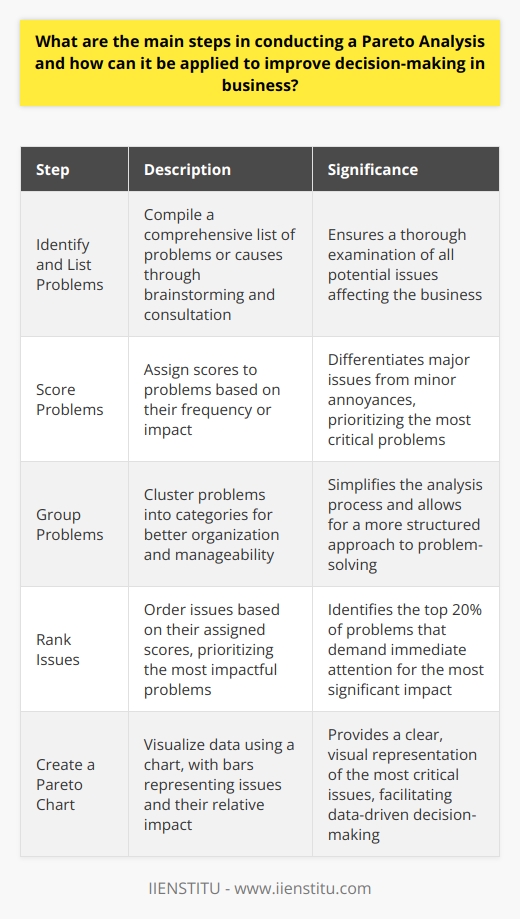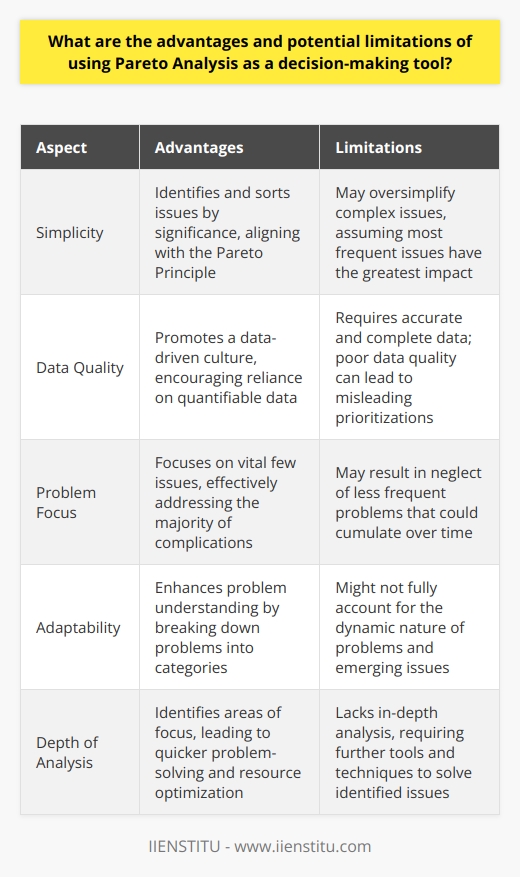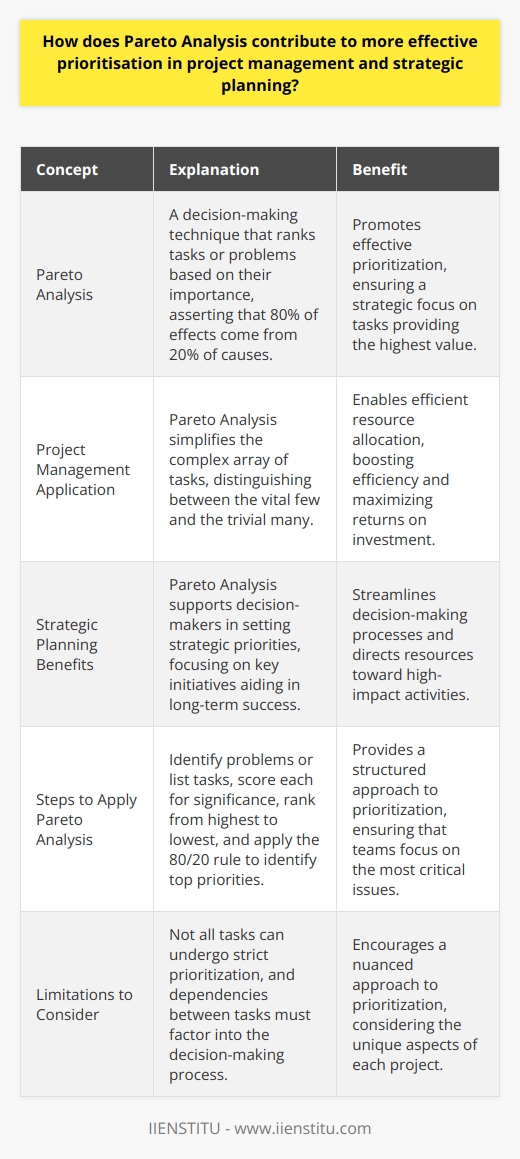
Pareto Analysis, a strategic tool based on the Pareto Principle, is instrumental in the realm of decision-making and prioritizing tasks. By distinguishing the "vital few" from the "trivial many", Pareto Analysis enables individuals and organizations to allocate resources more effectively, thereby optimizing outcomes.
The principle posits that roughly 80% of effects come from 20% of causes. Applying this analysis across various fields, from business management to software engineering, facilitates an enhanced understanding of the most significant factors contributing to a particular issue. This guide aims to delve into the intricacies of Pareto Analysis, providing a comprehensive understanding of its application and illustrating its importance with relevant examples.
The Pareto Principle: Understanding the 80/20 Rule
Thorough explanation of the 80/20 rule in the Pareto Analysis
The 80/20 rule, articulated by economist Vilfredo Pareto, is foundational to the Pareto Analysis. The principle emerged from Pareto's observations that 80% of wealth within Italy was owned by 20% of the population, a distribution which he later found to be applicable in various other domains.
In practical terms, the 80/20 rule suggests that a minority of causes, inputs, or efforts typically lead to a majority of the results, outcomes, or rewards. In the context of business, for example, it is often observed that 80% of sales might come from 20% of customers. Recognizing this disproportion allows entities to focus on the most impactful areas of their operation.
Human-centered Design And Design Thinking For User-friendly Products
Practical Techniques İn Descriptive Statistics For Data Analysis
Real-life examples of the 80/20 rule
Real-life implications of the 80/20 rule are manifold and span across different spheres of activity. In healthcare, for instance, 20% of patients might account for 80% of healthcare costs, which could lead to specific strategies for managing such expenses. In the realm of customer service, companies often find that a majority of complaints come from a relatively small fraction of customers, thus directing where customer service improvements can be most effectively made.
These examples illustrate how identifying the critical 20% enables organizations to target their efforts for maximum effect.
Explanation of how the 80/20 rule is applicable to various issues and processes
The 80/20 rule has a versatile applicability, extending its use to facets of personal productivity and organizational efficiency. One might discover that 20% of their study habits contribute to 80% of their learning problem solving skills. Similarly, in manufacturing, 20% of defects could be causing 80% of production issues, necessitating a focused quality control approach. Unpacking which areas underpin the majority of results provides a clear path to both problem identification and resolution.
The Process of Conducting a Pareto Analysis
Detailed step-by-step guide on how to conduct a Pareto Analysis
Conducting a Pareto Analysis is a systematic process that begins with the collection and categorization of data revolving around a specific problem. First, one must identify a list of problems or causes and quantify their frequency or impact. Next, these issues are sorted in descending order.
A cumulative frequency is calculated to understand the proportion each category contributes to the total. This data is then represented visually in a Pareto chart, where a distinct separation of the critical few (20%) from the trivial many (80%) should emerge.
Explanation of the purpose of each step in the process
Each step in the Pareto Analysis process serves a purpose to elucidate problem areas and prioritize action. Listing and quantifying issues creates a clear inventory of what requires attention. Ordering these issues by frequency or impact provides an objective basis for tackling them sequentially. Calculating cumulative impact underscores the significance of the top-ranking issues. The resulting Pareto chart outlines where efforts can yield the most substantial improvements, transforming complex data sets into actionable insights.
Practical example of a Pareto Analysis being conducted
Imagine an e-commerce business that faces multiple customer complaints. By listing complaints and aggregating the data, the company realizes that incorrect orders and delayed shipping comprise 80% of complaints despite only being two out of ten complaint categories. By concentrating on these areas, the business can disproportionately reduce the overall number of customer complaints, thus utilizing the Pareto Analysis to instigate a strategic improvement in customer satisfaction.
The Role of Pareto Analysis in Problem Solving and Decision Making
Explanation of how Pareto Analysis aids in identifying problems: Pareto Analysis is particularly powerful in problem identification, offering clarity by quantifying which issues have the most profound effects on a system. It serves to eliminate the noise of less significant problems, spotlighting those which, if solved, could have a considerable positive impact on the overall system. This refined focus effectively guides individuals and organizations in determining where to apply their efforts for the greatest return on investment.
Discussion on how Pareto Analysis interacts with decision-making processes: The insights garnered from a Pareto Analysis feed directly into decision-making processes by providing empirical evidence of priority areas. When choices must be made regarding resource allocation, time management, or strategic planning, Pareto Analysis offers a data-driven hierarchy of concerns. Decisions become informed, justified, and strategically geared towards optimal resource utilization and enhanced problem-solving efficacy.
Real-life case studies proving the effectiveness of Pareto Analysis in problem solving and decision-making: Numerous case studies validate the effectiveness of Pareto Analysis in decision-making and online certificate programs are a testament to this. For instance, an online education platform analyzing course completion rates might use Pareto Analysis to determine specific modules where students commonly disengage. By focusing on enhancing these critical sections, they can significantly improve completion rates across numerous programs. This methodology supports stakeholders to pinpoint issues and implement evidence-based decisions, resulting in tangible improvements in organizational performance.
The Advantages and Limitations of Pareto Analysis
Explanation of the key benefits of utilizing Pareto Analysis: Pareto Analysis offers several advantages, including a streamlined approach to diagnosing and treating the most pressing challenges within an entity. It encourages efficient resource allocation, promotes cost-effective strategies, and aids in setting clear priorities. Businesses and individuals who adopt Pareto Analysis can often achieve more with less, boosting productivity while reducing waste through targeted efforts.
Discussion on the limitations and potential challenges in conducting a Pareto Analysis: While potent, Pareto Analysis is not without its limitations. This methodology assumes that data is available and accurate, which may not always be the case. There are also scenarios where an overemphasis on the 20% could neglect issues that, although less significant individually, cumulatively could impose negative consequences if left unaddressed. Additionally, Pareto Analysis does not provide specific solutions but rather a framework for identifying areas needing attention.
Suggestions for overcoming the limitations of Pareto Analysis: To overcome limitations, it's crucial to employ Pareto Analysis alongside other decision-making tools, ensuring a balanced approach to problem-solving. When data is scarce or uncertain, complement the analysis with qualitative research or hypothesis testing. It's also critical to periodically revisit and reassess the analysis, especially in dynamic environments, to ensure that the areas of focus remain relevant.
Applying Pareto Analysis Across Different Industries
Explanation of how Pareto Analysis is applicable to different industries: Not confined to any single sector, Pareto Analysis has proven to be a universal tool with relevance across industries. By identifying the most significant factors within complex systems, it can influence the approach to issues in healthcare, finance, education, manufacturing, and beyond. In each industry, Pareto Analysis affords a means to discern inefficiencies, streamline operations, and elevate service or product quality.
Specific examples of industries where Pareto Analysis is particularly beneficial: Pareto Analysis has led to dramatic improvements in areas such as manufacturing, where it drives quality control initiatives by identifying the most common sources of defects. In marketing, it aids in optimizing advertising budgets by spotlighting the campaigns that yield the highest returns. In software development, focusing remedial efforts on the most frequently reported bugs via Pareto Analysis leads to more stable releases and improved user satisfaction.
Case studies demonstrating the application and effectiveness of Pareto Analysis in various industries: Case studies across sectors bear witness to the efficacy of Pareto Analysis. An automotive manufacturer might apply Pareto Analysis to reduce vehicle recalls by addressing the most common causes of failure. The financial sector uses Pareto Analysis to combat fraudulent activity by targeting the fraud types that result in the highest losses. Each case encapsulates the adaptability and utility of Pareto Analysis as a decision-making ally.
Conclusion
Summary of the key points covered in the blog: This comprehensive guide has traversed the essentials of Pareto Analysis, delineating its foundational 80/20 rule and illustrating its broad utility in problem identification and resource prioritization. With its structured approach, Pareto Analysis offers a lucid method for discerning which challenges warrant immediate attention and streamlined action.
Emphasis on the value and versatility of the Pareto Analysis: The value of Pareto Analysis lies in its ability to unearth the most significant contributions to an issue, allowing for targeted and effective interventions. Its versatility spans multiple industries and spheres, proving that this tool can be tailored to meet the unique needs of any context, thereby enhancing decision-making and delivering impactful outcomes.
Encouragement to readers to utilize Pareto Analysis in their respective fields: The insights and methodologies presented encourage readers to leverage Pareto Analysis within their respective fields. Beyond academic intrigue, its practical implications promise substantial benefits for all who apply it judiciously, be it in personal pursuits or professional undertakings. By embracing this analysis, one can expect not only to decipher the complex landscape of challenges but also to orchestrate strategic interventions that are both prudent and profitable.
Frequently Asked Questions
What are the main steps in conducting a Pareto Analysis and how can it be applied to improve decision-making in business?
Understanding Pareto Analysis
Pareto Analysis plays a pivotal role in decision-making. It is an approach advocating that 80% of outcomes stem from 20% of causes. This principle assists businesses in zeroing in on the most significant issues.
Steps in Conducting a Pareto Analysis
Identify and List Problems
Begin with compiling a list of problems or causes. Brainstorm and consult to gather an extensive set.
Score Problems
Assign scores to problems based on frequency or impact. This helps differentiate major issues from minor annoyances.
Group Problems
Cluster problems into categories. This makes the analysis manageable and organized.
Rank Issues
Order issues based on their scores. Prioritize to tackle the most impactful problems first.
Create a Pareto Chart
Visualize data with a chart. Bars represent issues; larger ones suggest greater impact.
Applying Pareto Analysis in Decision-Making
Focus on Critical Issues
Concentrate on the top 20% of problems. These demand immediate attention for the most significant impact.
Allocate Resources Efficiently
Apply resources to areas offering high returns. Don't dissipate effort across less critical issues.
Monitor Improvements
Track how changes affect the major issues. Ensure that interventions yield the desired effects.
Conclusion
Pareto Analysis simplifies complexity. It affirms that not all problems require equal resource expenditure. By targeting the most consequential issues, businesses can optimize decision-making and effectuate considerable improvements.

What are the advantages and potential limitations of using Pareto Analysis as a decision-making tool?
Advantages of Pareto Analysis
Pareto Analysis stands out for its simplicity. It requires users to identify and sort issues by significance. This prioritization technique aligns with the Pareto Principle. This principle suggests that 80% of problems stem from 20% of causes. By focusing on a few critical issues, one can effectively address the majority of complications.
The clear visualization aspect is another benefit. Pareto Analysis often employs bar charts, which show the relative frequency or impact of problems. By providing a visual representation, stakeholders can quickly comprehend the data. This clarity aids in communication within teams.
Decision-making efficiency improves as well. Pareto Analysis condenses vast amounts of data into actionable insights. This leads to quicker problem-solving as teams focus on the 'vital few' issues rather than the 'trivial many'.
The tool promotes resource optimization as well. Organizations can allocate resources effectively by targeting areas with maximum impact. This ensures better use of time, money, and personnel.
Pareto Analysis also fosters a data-driven culture. It leads teams away from decision-making based on intuition. Instead, it encourages reliance on quantifiable data.
Lastly, Pareto Analysis enhances problem understanding. By breaking down problems into categories, teams gain insights into root causes. This understanding is critical for developing sustainable solutions.
Potential Limitations of Pareto Analysis
Despite its strengths, Pareto Analysis has limitations. One such limitation is the oversimplification of complex issues. It assumes the most frequent issues have the greatest impact, which isn't always true.
Another is the quality of data required. The analysis hinges on accurate and complete data. Poor data quality can lead to misleading prioritizations.
Pareto Analysis may also result in neglect of less frequent problems. Minor issues might cumulate over time, eventually requiring critical attention.
There is also a dynamic nature to problems. Problems evolve, and Pareto Analysis might not fully account for this. Relying solely on Pareto could mean missing out on emerging or evolving issues.
In addition, Pareto Analysis lacks in-depth analysis. It identifies areas of focus but doesn’t provide solutions or root cause analysis. Further tools and techniques are necessary to solve the identified issues.
Finally, the approach might lead to a complacency or false sense of control. Focusing heavily on the 'vital few' may give the illusion that one is addressing all crucial aspects of a problem, potentially missing out on the bigger picture.
Conclusion
Pareto Analysis offers a structured approach to decision-making. It emphasizes efficiency, resource optimization, and better understanding of problems. Yet, its efficacy depends on data quality and it can oversimplify issues. By acknowledging its limitations and using it alongside other analytical tools, decision-makers can fully leverage Pareto Analysis for more strategic outcomes.

How does Pareto Analysis contribute to more effective prioritisation in project management and strategic planning?
Pareto Analysis in Prioritization
Pareto Analysis, widely known as the 80/20 rule, asserts that 80% of effects come from 20% of causes. In project management, this powerful principle aids in identifying the most significant issues impacting a project. It promotes effective prioritization, ensuring a strategic focus on tasks providing the highest value.
Understanding Pareto Analysis
To begin with, Pareto Analysis is a decision-making technique. It helps to rank tasks or problems based on their importance. The idea is to ascertain which tasks, if completed, would yield the most significant overall benefit.
The Role in Project Management
Within project management, Pareto Analysis simplifies the complex array of tasks. It distinguishes between the 'vital few' and the 'trivial many'. Project managers can thus allocate resources where they matter most. This allocation boosts efficiency and maximizes returns on investment.
Strategic Planning Benefits
Strategic planning also gains from Pareto Analysis. This analytical tool supports decision-makers in setting strategic priorities. It enables them to focus on key initiatives aiding in long-term success.
Steps to Apply Pareto Analysis
To apply Pareto Analysis in project management and strategic planning, several key steps are necessary:
- Identify problems or list tasks.
- Score each problem or task for significance.
- Rank them from highest to lowest.
- Apply the 80/20 rule to identify top priorities.
The Impact on Decision Making
By focusing on critical issues, decision-making becomes more streamlined. Teams don't waste time on problems with minimal impact. They drive project advancement more effectively.
Enhancing Resource Allocation
Pareto Analysis directs resources toward 'high-impact' activities. It ensures that teams do not spread thin over lesser issues. Managers can assign skilled manpower to crucial tasks.
Improving Time Management
Effective prioritization inherently boosts time management. Teams can avoid investing time in areas with limited returns. They maximize their productivity by targeting pivotal areas.
Encouraging Data-Driven Decisions
This analysis encourages a data-driven approach. Teams bypass biases and make informed decisions based on quantifiable data.
Limitations to Consider
However, apply Pareto Analysis with caution. It's crucial to recognize that not all tasks can undergo strict prioritization. Some projects may require a more nuanced approach. Dependencies between tasks must also factor into the decision-making process.
Conclusion
Pareto Analysis serves as a beacon in the murky waters of project management and strategic planning. It shines a light on what truly matters. By applying this simple yet profound principle, managers and planners can navigate toward more successful and efficient outcomes.



